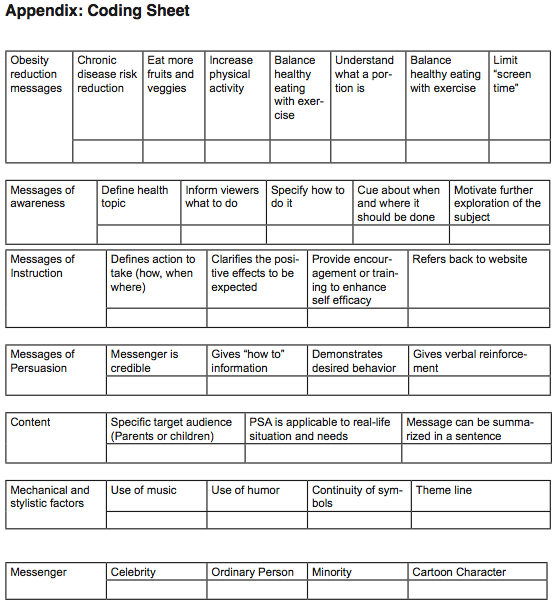From Elon Journal of Undergraduate Research in Communications VOL. 4 NO. 1Motivating Behavior Change: A Content Analysis of Public Service Announcements From the Let's Move! CampaignIII. MethodsIn order to explore how health messages are communicated to motivate behavior change in the Let's Move! campaign, a content analysis was performed on all 13 print advertisements and six television public service announcements released in the spring of 2011, which marked the one-year anniversary of the Let's Move! campaign. Content analysis is a method of research for "making reliable and valid inferences from data to their context, with the purpose of providing knowledge, new insights, a representation of facts and a practical guide to action" (Krippendorff, 1980). By performing a content analysis, the researcher is able to analyze messages and make conclusions from data. To ensure accurate results, the researcher develops a coding sheet in which categories are created for what exactly the researcher looka for in the selected content. By creating categories and coding the content, certain characteristics of the message can be analyzed and interpreted for underlying themes and patterns. (Krippendorff, 1980). Before research was conducted to explore how health messages are communicated to motivate behavior change in the Let's Move! campaign, the author developed a coding sheet modeled after Atkin's research of effective PSA strategies, which were drawn from the social cognitive theory and health belief model and research about successful health communication strategies (2011). Each PSA was analyzed with the same coding sheet to keep findings consistent. The coding sheet consists of seven categories: Obesity reduction messages, messages of awareness, messages of instruction, messages of persuasion, content, mechanical and stylistic factors and messenger (see Appendix). PSAs were viewed a total of seven times by the researcher, each time to detect any element for each category. The researcher accessed these PSAs through the Let's Move! Toolkit, which is available on the Let's Move! campaign website. First, the researcher identified what message(s) about obesity prevention were being communicated to publics. The PSAs were then viewed to explore the way messages were communicated based on Atkin's research about effective PSA strategies to facilitate behavior change; PSAs were studied based on the existence of messages of awareness, instruction, and persuasion (2011). Messages of awareness were considered to exist if the PSA defined the health topic, viewers were educated about what, how, when, and where to fix the health problem, and if viewers were prompted to explore the subject of obesity prevention and reduction to a fuller extent. Messages of instruction were considered to exist if the action to prevent childhood obesity was defined, positive effects of the action were clarified, encouragement and direction was provided to enhance self-efficacy, and if the ad referred back to the Let's Move! campaign website for further direction. Messages of persuasion were considered to exist if the messenger was credible, gave "how to" information, demonstrated the desired behavior, and gave verbal reinforcement to publics. PSAs were also coded for their content, another factor Atkin deemed important to yield behavior change (2011). The author analyzed PSAs to see if they defined a target audience, if the requested action(s) were applicable in real life situations and if the overall message was understandable and could be summarized in one sentence. These factors were checked to determine the possible effectiveness or ineffectiveness in yielding behavior change among publics. Mechanical and stylistic factors were also considered when analyzing PSAs to determine how the message was communicated through use of music, humor, continuity of symbols and theme. Lastly, the messenger was checked to identify who was delivering the message—a celebrity, ordinary person, minority, or cartoon character. The author also recorded qualitative comments for each PSA and was able to infer that she did not anticipate. By coding PSAs for the existence of the above factors, the author was able to draw conclusions about how health messages are communicated in the Let's Move! campaign PSAs to motivate behavior change among publics. IV. FindingsResults from the content analysis of print and television public service advertisements from the Let's Move! campaign yielded several findings. All 19 PSAs contained a salient obesity reduction message that was aligned with the Let's Move! campaign goals. Fourteen PSAs urged audiences to increase physical activity while 10 PSAs encouraged viewers to eat more fruits and vegetables. Findings indicated that health messages were communicated through a consistency of the campaign theme, by specifically targeting an audience and showing the requested behaviors to change rather than telling. The ways in which the Let's Move! PSAs communicates health messages are in align with the social cognitive theory and health belief model. Let' s Move! Campaign Consistency The Let's Move! campaign shows consistency in its messages, logos and themes, therefore, creating a culture for the campaign that is constant and easy to recognize. The 19 PSAs can be grouped into different sets of ad campaigns, but all PSAs contain the same underlying message and theme: To stay active and eat healthy. Seven print and one TV PSA titled "On the Daily" are geared towards parents and children urging them to adopt a different healthy habit each day of the week. One print and one TV PSA called "Mom Was Here" urges moms to use unique strategies to take action and keep their kids active and eating healthy. One print and one TV PSA are part of the "T-shirt" campaign, which educates and encourages Spanish-speaking parents and children to eat healthy and stay active. Three TV PSAs titled "The Magic of Healthy Living" coordinated with the Disney Channel to encourage kids to engage in friendly competitions to eat healthy and get active. Four PSAs titled "Remember" were created specifically for those living in Indian Country, and they call on parents to get their kids active and eating healthy. In each PSA campaign grouping, the message and theme were consistent and easily recognizable. In all three "Magic of Healthy Living" TV PSAs, the messengers were the same, but in each PSA they were verbally demonstrating different ways to eat healthy and stay active. Although each separate ad campaign contains diverse messengers and situations, the inherent message about how to reduce childhood obesity is constant. Health messages are communicated with a consistent symbol in most of the Let's Move! PSAs: A logo with the Let's Move! webpage URL. The logo refers viewers back to the campaign website for more information, therefore motivating further exploration of the subject. The consistency in the campaign is carried out in both the print and television advertisements, creating a cohesive culture for the Let's Move! campaign. The only distinction in this consistency is in the four "Remember" print PSAs targeted to publics living in Indian Country. The logo on these PSAs include the Let's Move! symbol, but underneath it says, "In Indian Country." In these PSAs, the Let's Move! logo does not refer publics back to the website. Instead, the logo is surrounded by an image of two people playing with a ball. This overall logo is different from the rest of the Let's Move! logos displayed on campaign PSAs but it is still easily recognizable with the campaign because the same font and colors are used. Specifically Targeted Audience Findings indicate that all PSAs in the Let's Move! campaign targets a specific audience: Parents and kids. The PSAs titled "T-shirt" and "On the Daily" target both parents and kids in unique ways. The "On the Daily" PSA campaign appeals to kids because the children are shown doing fun and exciting activities with their friends. The messengers were children from diverse backgrounds and, therefore, have the potential to appeal across a broad audience. The "On the Daily" PSA campaign also appeals to parents: Moms and dads of diverse backgrounds are pictured in the print PSAs next to their kids with tips on how to encourage kids to adopt healthy behaviors. Other PSAs in the Let's Move! campaign are more specific and directly target a certain parent. The "Mom was Here" PSAs target mothers--they show what moms are doing to keep their kids healthy, and instruct moms how to communicate with their kids to keep them eating healthy and staying active. Two out of the four print PSAs created for Indian Country titled "Remember" target a certain parent: One PSA targets to mom and one PSA targets dad. These PSAs directly use the words "Mom" and "Dad" to communicate to a specific parent how to take action to keep their kids active. "The Magic of Healthy Living" Let's Move! TV PSAs specifically target children. These PSAs show kids playing and eating healthy with their friends in real world situations that can be easy for a kid to mimic. To specifically target kids, the "Magic of Healthy Living" PSAs use appealing visuals, humor and music. Furthermore, the messengers of these PSAs are easily recognizable Disney Channel celebrities that are role models to kids. Findings indicate that all Let's Move! PSAs analyzed have a specific target audience, but they are also trying to appeal across a broad audience of publics with different races and socio-economic backgrounds. Every PSA campaign contains children and parents from minority races such as African American, Hispanic and Asian as well as Caucasian kids. Children in the PSAs also have different body heights, weights and ability levels to increase its universal appeal. Furthermore, the "Remember" PSA campaign is specifically targeted towards parents living in Indian Country, and the "T-Shirt" campaign is specifically targeted to Spanish-speaking Americans. The "T-shirt" PSA shows a young boy of Spanish decent wearing different tshirts that have Spanish writing on them, instructing parents how to keep their kids active and eating healthy. The PSAs are also attempting to appeal to publics from a variety of socio-economic backgrounds because the messages encourage parents and children to take part in activities that require little money and resources. In the TV PSA "On The Daily," children from minority groups and from a variety of socio-economic backgrounds are shown playing and doing activities that are easy to do outside with little money and resources involved such as playing hopscotch and freeze tag. In the TV PSA "Magic of Healthy Living: Sandwich Star," the PSA demonstrates how easy it is to make a sandwich healthy with little ingredients and money involved. The "Mom Was Here" PSAs encourage moms to do things such as turning off the power or connecting what their kids love to do with healthy eating. These activities do not require money or resources and, therefore, appeal to publics from all different socio-economic backgrounds. Show Rather Than Tell All PSAs analyzed in the Let's Move! campaign show the requested health action rather than just tell target publics what to do. The PSAs use concepts from Bandura's social learning theory to show publics through modeling, so individuals are more likely to make the requested behavior change (1977). These actions are shown through how-to examples and verbal reinforcement of the message. In the "Magic Of Healthy Living" TV PSAs, friends are shown playing basketball and competing in a healthy sandwich making competition. These activities are easy to imitate and provide specific how-to information so that target audiences are instructed with no guesswork involved. Furthermore, TV PSAs verbally reinforce the how-to messages shown. In the TV PSA "Magic of Healthy Living: Sandwich Star," Michelle Obama congratulates both kids on a competition about how to build a healthy sandwich, giving verbal reinforcement and guidance, therefore, possibly increasing the likelihood that the requested behavior change will be made by the target audience. In the TV PSAs that have corresponding print ads, the messages are reinforced with specific how-to information. The "On the Daily" TV PSA features a song instructing kids and parents about a healthy change to make each day. The lyrics begin with "Today is Saturday. Small plate Saturday, football Friday . . . walk it off Wednesday, touch your toes Tuesday lets move Monday swap a snack Sunday" (Ad Council, 2011). In the related print PSAs, each day is separated into a separate print PSA, and showed exactly what behavior change kids should be making or parents should be endorsing each day of the week with a detailed example, providing the audience with how-to information and reinforcement in writing. The "Mom Was Here" PSAs show specific, how-to examples of how moms can keep their children healthy and active but also verbally reinforce the message to eat healthy and stay active. The "Mom Was Here: Blackout" TV PSA shows a mom briefly shutting off the power at home, turning off the video games her kids are playing so that they are forced to play outside. This specific how-to information provokes the viewer to perform the requested action because they are learning from example and the voice-over encourages moms to take action and visit the Let's Move! website for more ideas. The "Mom Was Here: Cantaloupe" print PSA contains text that tells the story of a mom telling her daughter that astronauts like cantaloupe, connecting something her child loves with healthy food to get her to eat better. This specific how-to instructional message was present in every PSA analyzed. Verbal reinforcement of the instructional message was present in every TV PSA analyzed.Continued on Next Page » Suggested Reading from Inquiries Journal
Inquiries Journal provides undergraduate and graduate students around the world a platform for the wide dissemination of academic work over a range of core disciplines. Representing the work of students from hundreds of institutions around the globe, Inquiries Journal's large database of academic articles is completely free. Learn more | Blog | Submit Latest in Business & Communications |




















